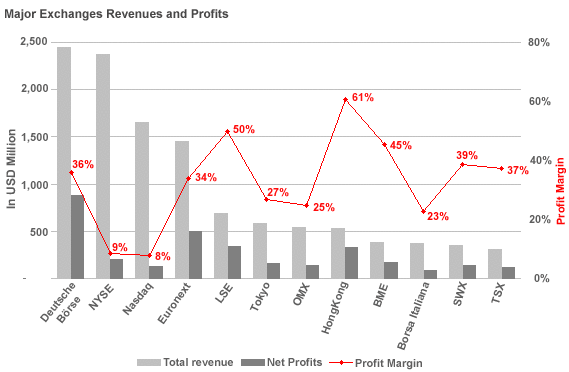Global Securities Exchanges Landscape
Abstract
Global Securities Exchanges
The global capital market is undergoing a series of major structural changes, due largely to demutualization, consolidation, and competitive threats from alternative trading systems.
The exchange industry is evolving rapidly. Worldwide competitive pressure has motivated many exchanges to change their structural model of governance from member-owned and not-for-profit organizations to publicly traded companies. The 12 major exchanges are all demutualized organizations in terms of revenues, and only four of them are unlisted companies.
The exchange industry has consolidated at both the regional and global levels. This process has been accelerated over the past two years with the NYSE-Euronext merger, which created the largest stock exchange worldwide, in addition to the merger of CME and CBOT, which resulted in the world's largest derivatives exchange. According to a new report from Celent, , demutualization and consolidation will continue in the near future.

"Demutualized structures are more flexible and reactive to the fierce competition," said Perrine Fiorina, Celent analyst and author of the report. "Consolidation represents the means of achieving revenue and cost synergies towards expanding trading activities and diversifying revenue sources."
Other key findings of the report include:
- The majority of exchanges diversify their revenue sources and not only provide listing, trading, and information services but also post-trading services and technologies. Furthermore, many exchanges offer both securities and derivatives trading.
- The American NYSE and Nasdaq exchanges are still leaders in volume and value, but exchanges in the Asia-Pacific region have been the most dynamic and fastest growing markets over the past two years.
- The global value of initial public offerings reached a record in 2006, with US$246 billion raised through 1,729 IPOs. The first half of 2007 has also been impressive.
- Derivatives instruments have become more and more popular, with global derivative trading volume increasing by a compound annual growth rate of 22% between 2000 and 2006.
This report also provides an analysis of the major equities and derivatives exchanges' strategies towards facing competition with alternative trading systems (ATSs), brokers, and private equity firms.
A table of contents is available online. The 31-page report contains 22 figures and four tables.
Members of Celent's Securities & Investments research service can download the report electronically by clicking on the icon to the left. Non-members should contact info@celent.com for more information.

